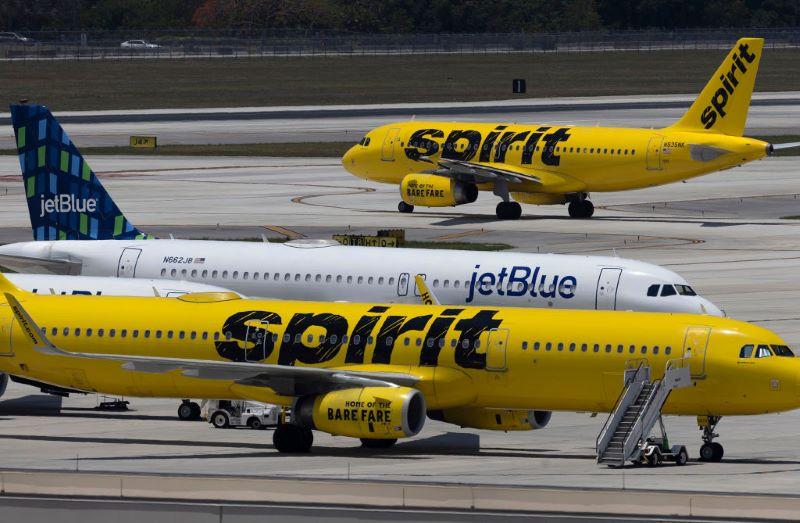JetBlue-Spirit Judge Weighs Divestitures, Considers Injunction Limitations

BOSTON—During closing arguments of the antitrust trial challenging a merger between JetBlue Airways and Spirit Airlines, a federal judge weighed the efficacy of divestitures and the restrictions of a full injunction.
“Suppose as I work through this, and think what I have before me is insufficient and warrants some restraint, but with some more divestitures it might work … Should I go down that route?” U.S. District Judge William Young asked attorneys for the U.S. Justice Department (DOJ), one of a few hypotheticals he posed during the Dec. 5 session.
DOJ, the Plaintiff, pointed to the “the extent of harm” for which it has built a case in court since proceedings began on Oct. 31—concerns centering on what it describes as a loss of Spirit’s ULCC business model and a detriment to consumers it values at $1 billion annually, with anticompetitive effects it sees on more than 150 routes.
“It is difficult for me to imagine substantively, what kind of remedies could offset this,” responded DOJ attorney Edward Duffy. “There does not seem to be any remedy, short of a full stop injunction.”
In its initial complaint filed in March as it sought to stop the merger, DOJ asked that the Defendants be permanently restrained from carrying out the acquisition, or any other transaction in any form that would combine JetBlue and Spirit. Judge Young, noting the dynamic nature of the industry as it faces unique post-pandemic challenges, told attorneys he was “having trouble” with a permanent injunction, describing himself as “hesitant” to implement the measure. To representation for the defense, he asked, “If I were to fashion an injunction, what sort of limitations or steps for further consideration or review should I build into it?” Any remedy should be narrowly tailored, replied JetBlue attorney Ryan Shores, stating, “I think the underlying principle here is that the court would have to tailor any remedy to a specific harm that it found in this case.”
Before posing his hypotheticals Young cautioned that his questions did not indicate the inclination of the court, but rather “indicate issues I’m thinking about, nothing more.”
Arguments from JetBlue and Spirit, the sixth and seventh largest U.S. airlines, have focused their need to merge on an ability to create a “viable” fifth challenger to compete with the biggest four legacy carriers—airlines which have grown through their own past mergers and acquisitions.
DOJ’s rebuttal in part pointed to previous testimony from Frontier Airlines CEO Barry Biffle, who said his ULCC didn’t overexpose itself to routes already dominated by the Big Four. DOJ also argued that JetBlue statements on slow and difficult organic growth were directly at odds with its assertions that Frontier and other ULCCs could grow at “astronomical” rates. ULCCs “as a flock and individually” are too small to make up for a loss of Spirit, attorneys for the Plaintiffs told the court. Biffle in his testimony said it would take his airline 7-8 years to replace Spirit, “based on concrete plans of Frontier’s growth,” noted Duffy, while venturing that he could perhaps do it inside of five years. “That type of speculation is the exact kind of evidence that is insufficient,” Duffy said.
In an attempt to assuage some of DOJ’s concerns, JetBlue has committed to divesting Spirit assets at New York LaGuardia to Denver-based Frontier, and at Boston Logan and Newark Liberty to Las Vegas-based ULCC Allegiant Air, in addition to relinquishing up to five gates at Fort Lauderdale. In court, airline attorneys described the divestitures as having the ability to “turbocharge” the two ULCCs, while contending that the unbundled model pioneered by Spirit is no longer unique. It was a point Judge Young noted in asking DOJ to elaborate on exactly what innovations would be lost should a merger ensue. DOJ projected more to come, due to the very environment Spirit now finds itself in.
“Spirit is trying to cut costs now,” said Duffy. “Many of the innovations Spirit has developed has been in response to that pressure to cut costs.”
In contrast, attorneys for the defense have argued that Spirit’s financial performance is keeping it from achieving planned growth, with eight consecutive quarterly net losses as of the third quarter and expectations of a net loss for the full year as well. “I don’t have an estimate as to when we intend to return to profitability,” Spirit CEO Ted Christie said in court Nov. 1, revealing that the airline began evaluating mergers in 2016 out of concerns that independent growth was insufficient. Addressing previous projections of growth during closings, Spirit attorney Jay Cohen said, “the plan was just a plan, it’s not being executed on. Spirit is really in uncharted waters.”
“Don’t I have to look out in the future?” Judge Young asked DOJ in considering the financials. “We’re not going to get anywhere if you win, I enjoin this merger, and Spirit goes belly-up.” DOJ projected that, at most, Spirit’s growth would slow, pointing to its past growth rates, while reiterating a central argument that a merger would result in the elimination of roughly half the ULCC capacity in the country.
It was a point on which the judge directly questioned airline attorneys.
“If this merger goes through there will remain a spectrum of prices and competition among the airlines that will go down to basic economy, but it seems that Spirit’s model will be lost,” said Young. While acknowledging that Spirit “will not be a part of that particular model going forward,” representation for JetBlue said, “the model will be there,” pointing to the 4-5 years JetBlue would need to retrofit all Spirit aircraft as providing time for other ULCCs to “fill the void.”
Also noting the emergence of newer carriers including Breeze and Avelo, and growth plans outlined by existing ULCCs Allegiant and Frontier, Shores said, “Particularly in a dynamic industry, you can’t take a snapshot of what the world looks like today—the industry evolves.”
A ruling is expected by year-end or soon thereafter.



